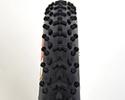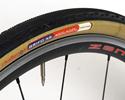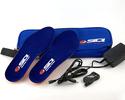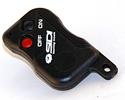
Recently on Cyclingnews.com |
Quick Spins – December 19, 2007Edited by James Huang Got Tech? Send press releases, news, and tech questions to the Cyclingnews tech-heads. Welcome to Quick Spins, an all new section within Cyclingnews' tech coverage were we put some of the smaller items that land on the tech desk to the test.
Dugast may get the bulk of the limelight, but Challenge tires are almost as highly prized in the cyclo-cross race scene and are used by several top riders, including Erwin Vervecken of Fidea. In many ways the company is a resurrected form of legendary Clement, and its current products reflect the old-school methods that were originally used in those days. Unlike many tires currently on the market, Challenge tires are fully handmade and omit the vulcanisation process that is typically used to co-mold the tread on to the casing. According to Challenge, the latter induces residual stress into the casing (i.e. it wants to lay flat instead of round) and adversely affects casing flexibility. Instead, the supple 260tpi polyester casing is cut and formed by hand, and the separate tread is bonded on (again, by hand) to a fully inflated casing with a puncture resistant belt sandwiched in between. The result, says Challenge, is a tire that is far more capable of conforming to the ground for better traction, lower rolling resistance, and more comfort. Challenge offers just two cyclo-cross tread patterns: the rather familiar-looking Grifo and the diamond-file semi-slick Grifo XS. Both are offered in tubular (30, 32, or 34mm width) and open tubular varieties (32mm only) and our test samples comprised one of each major division. Our Grifo 32 tubulars were 450g apiece and the accompanying Grifo XS open tubulars hit the scales at an impressive 359g each. Straight out of the box, both sets of tires are notably softer and more flexible than conventional vulcanised tires, as we've come to expect with handmade construction of this sort. Mounting was a non-issue in both cases, although straightening the tubular Grifo 32 tubulars was a bit tricky since the width of the hand-glued tread and its position relative to the base tape varied a bit around the tire circumference. None of that mattered once we got the tires out on the dirt, though. Both sets delivered a fantastically compliant ride quality that was clearly superior to vulcanized models, and the tubulars were even better as we were able to regularly run as little as 30psi little fear of pinch flatting. That extra-low pressure also produced a larger contact patch on our tubular Grifo 32, which provided astounding grip on grassy courses and softer dirt (just make sure they're glued well!). They were still fast rolling on hardpack and pavement, too, but their small and relatively soft compound knobs wore quickly and tended to slide (predictably) when pushed on those surfaces. The Grifo XS open tubular was notably faster in those conditions and simultaneously seemed to offer better cornering grip as well since its file tread put more rubber on the ground. Cornering on grass was surprisingly similar to its more aggressive counterpart (as long as it wasn't wet) thanks to a smattering of side knobs, although the lack of tread down the center compromised braking a bit. Potential buyers should choose their tire model and casing widths carefully based on their home turf but both treads are surprisingly versatile (as long as it isn't muddy) so you likely won't pay too big of a price if you pick incorrectly. Either way, the superb casing will deliver race-ready ground tracking, a fast roll, and a fantastic ride that blows most any vulcanized tire out of the water. The 'handmade' aspect does yield some imperfections, but the end result works so well that you almost certainly won't care. /JH Price: US$99.99 (Grifo or Grifo XS tubular); US$79.99 (Grifo
or Grifo XS open tubular) |
|
|
|
|
|
Sidi comes to the rescue for cyclists who suffer cold feet with a pair of heated insoles that are meant to replace standard inserts in winter weather. Beneath the forefoot of each insole is a flexible resistive heating element powered by an embedded rechargeable lithium ion battery. The addition of an implanted temperature sensor and controlling microprocessor promises to maintain a cozy 38°C (100°F) inside your shoe.
Included with the Toasters are a wall charger that simultaneously charges both insoles and indicates a full charge via a colored LED, and a small remote control (similar to an automobile key fob) that can turn the heaters on or off as long as they're within a 3m range. A convenient carrying case keeps it all together.
Installation couldn't be simpler as the Toasters replace standard insoles and come in sizes to fit nearly any Sidi shoe (or other makes and models). Their shape closely approximates stock Sidi units to maintain form and fit, but at 170g per pair, they are slightly heavier due to the extra hardware.
I tested the Toasters in standard non-winter Sidi and Shimano shoes in temperatures as low as -3°C (27°F), on- and off-road, and in conjunction with external shoe covers in the coldest conditions. I've frozen my feet on rides countless times during more than twenty US East Coast winters, so they can no longer keep themselves warm for more than 30 - 40 minutes during any average winter spin. My feet never went uncomfortable or numb when using the Toasters, though, and they quickly worked their way on to my cold-weather riding gear essentials list after just a single outing. Sure, my toes still sometimes got cold riding the road in my coldest and windiest test conditions, but the painful post-ride thaws were but a not-so-fond memory.
My Toasters always lasted for the claimed three to four hours or beyond, and also survived a few (unintentional!) dabs into stream crossings. It should be noted that the insoles will consume more power in colder conditions to maintain their preset temperature so "run time" will shrink accordingly, but their lithium polymer battery is advertised for 600 charge cycles without memory damage.
The US$299 price tag will undoubtedly make some potential buyers squirm, but they're actually a bit cheaper than disposable chemical toewarmers in the long run and work superbly. Plus, it's not like you can buy new toes! /SG
Price: US$299.00
Available sizes: 39 to 48
Pros: Maintains a suitably warm environment while remaining
compatible with a wide range of shoes and all shoe covers, easy
installation and removal, simple charging procedure, included carrying
case, economical over the long run
Cons: Expensive initial investment, may not be compatible
with some orthotics, requires AC power source to recharge between
uses
Cyclingnews rating: ![]()
More info: www.veltecsports.com
Photography
For a thumbnail gallery of these images, click here
Images by James Huang/Cyclingnews
- The complete package includes the insoles, a charger, an international adapter (not pictured), a remote, and a handy carrying case.
- Charging the insoles is simple: just pry away the plastic plug and connect them to the wall charger.
- A remote lets you turn on or off the insoles from anywhere within three meters.
- All electronics, including the heating element are neatly packaged within the insoles, which feel just slightly heavier than Sidi's standard insoles.
![]()







